Documents: Go to download!
User Manual
- Owner's manual - (English)
- Beko DFN16420X Freestanding Dishwasher Installation Guide - (English)
- DFN16420X - Beko - Specifications Sheet - (English)
Owners' Guide Dishwashers
Dishwasher
Overview

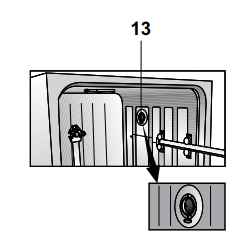
- Tabletop (depends on the model)
- Upper impeller
- Lower basket
- Lower impeller
- Filters
- Control panel
- Door
- Detergent dispenser
- Lower impeller slot
- Silverware basket
- Upper basket rail
- Upper basket with rack
- Fan drying system (depends on the model)
Prewashing
Tips for energy saving
Following information will help you use the product in an ecological and energy-efficient manner.
- Wipe away any coarse food remnants on the dishes before putting them in the product.
- Operate the product after filling it completely.
- When selecting a programme, refer to the “Programme Table”.
- Do not put more detergent than suggested on the detergent package.
Detergent
You can use powder or tablet detergent in the machine.
CAUTION: Only use in the machine the detergents produced particularly for use with dishwashers. We recommend you not to use detergents that contain chlorine and phosphate as they are harmful for the environment.
CAUTION: Contact the detergent producer if the dishes are wet and/or if you notice limescale spots particularly on glasses after the washing programme is over.
Adding detergent
CAUTION: Refer to the “Programme Table” to determine the correct amount of detergent for the selected programme.
WARNING: Do not put solvents into the detergent dispenser. There is the risk of explosion!
Put the detergent into the detergent dispenser just before operating the machine as illustrated below.
- Push the latch to right to open the detergent dispenser lid (A).

- Put suggested amount of powder or tablet detergent in the dispenser.
CAUTION: Inside the detergent dispenser, there are level markings that help you use appropriate amount of detergent. When brimful, detergent dispenser will contain 40 cm³ of detergent. Fill detergent up to 15 cm³ or 25 cm³ level marks in the detergent dispenser according to fullness of the machine and/or soiling degree of the dishes (1).

CAUTION: If dishes have been waiting for a long time and have dried residues, fill the 5 cm³ compartment too (5). - Close the detergent dispenser lid by pressing on it lightly. A “click” will be heard when the lid is closed.
CAUTION: In programmes with prewash and at high temperature, in which you use tablet detergents, make sure that the detergent dispenser lid is closed firmly.
See other models: DR14W EDW7W FI14BM GS65260XAU GS60NZVI
CAUTION: Use powder detergent in short programmes without prewash since the solubility of the tablet detergent changes depending on the temperature and time.
WARNING: Excessive usage of powder detergents will cause the detergent not dissolve completely and will also cause scratches on the glassware.
Rinse aid
CAUTION: The rinse aid used in dishwashers is a special combination used to increase drying efficiency and prevent water or limescale stains on the washed items. For this reason, care must be paid to have rinse aid in the rinse aid reservoir and to use rinse aids produced specially for dishwashers only.
Check Rinse Aid Indicator to determine whether it is necessary to add rinse aid or not 3 (depends on the model). Having a dark light on the indicator shows that there is sufficient amount of rinse aid in the dispenser. If the colour of the indicator is light, add rinse aid.
- Open the lid of the rinse aid reservoir by pressing its latch (B).

- Fill the reservoir until “MAX” level.
- Close the lid of the reservoir by pressing on it lightly.
CAUTION: Wipe clean any spilled rinse aid outside the reservoir. Rinse aid that spilled accidentally will cause foaming and it will eventually decrease washing performance.
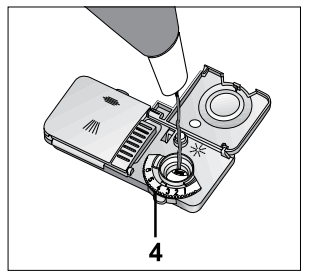
- Turn the rinse aid amount adjuster manually to a position between 1 and 6 (4). If there are stains on tableware items after washing, level must be increased and if there is a blue trace after wiping them by hand, it must be decreased. This is set to position 4 as factory default.
Items not suitable for washing in the dishwasher
- Never wash dishes soiled by cigarette ash, candle remnants, polish, dyestuff, chemicals, etc. in your dishwasher.
- Do not wash iron alloy items in the dishwasher. It can get corroded or leave stains on other items.
- Do not wash silverware and cutlery with wooden or bone stems, glued pieces, or pieces that are not resistant to heat, as well as copper and tin-plated containers in the dishwasher.
CAUTION: Decorative prints of chinaware as well as aluminum and silver items may get discoloured or tarnished after washing in the dishwasher just as it happens in handwashing as well. Some delicate glass types and crystals may become dull in time. We strongly recommend you to check if the tableware you are going to purchase is suitable for washing especially in the dishwasher.
Placing the dishes into the dishwasher
You can use your dishwasher in the optimum way with respect to energy consumption and washing and drying performance only if you place the dishes in an orderly way.
- Wipe away any coarse food remnants (bones, seeds, etc.) on the dishes before placing them in the dishwasher.
- Place thin, narrow pieces in the middle sections of baskets if possible.
- There are two separate baskets in which you can place your dishes in the dishwasher. Place the heavily soiled and bigger items in the lower basket and smaller, delicate and light items in the upper basket.
- Place the hollowed dishes such as bowls, glasses and pans upside down in the dishwasher. Thus, accumulation of water in deep hollows is prevented.
CAUTION: To prevent possible injuries, always place the sharp and pointed dishes such as service fork, bread knife, etc. upside down so as their pointed ends will face down or they will lie horizontally on the dish baskets.
- Unload dishes in the lower basket first and then the dishes in the upper basket.
Suggestions for loading the dishwasher


Improper Loading Of Dishware

Improper Loading Of Dishware
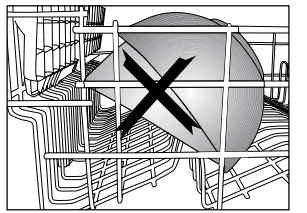



Silverware basket (depends on the model)
Silverware basket is designed to wash your dishes such as fork, spoon and etc. in a cleaner manner.

Silverware basket piece (depends on the model)
You can place your forks, spoons and etc. to upper basket with the additional piece in the figure.
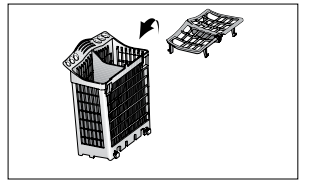

Movable silverware basket (depends on the model)
Since the cutlery basket can be moved (A, B), you can create a wider space while placing your dishes to the lower basket and free up space for your dishes in different sizes.
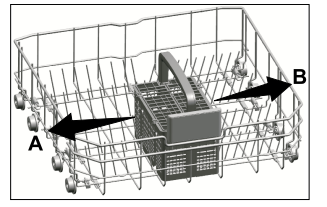
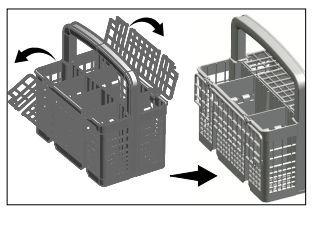
Collapsible lower basket wires (2 pieces) (depends on the model)
The two piece foldable wires located at the lower basket of the machine are designed for an easier placement of large pieces such as pans, bowls, etc. (1, 2). You can create larger spaces by folding each wire individually or all of them at once. Lay the foldable wires down by pressing on the latch (A).


Collapsible lower basket wires (4 pieces) (depends on the model)
The four piece foldable wires located at the lower basket of the machine are designed for an easier placement of large pieces such as pans, bowls, etc. (1, 2, 3, 4). You can create larger spaces by folding each wire individually or all of them at once. Lay the foldable wires down by pressing on the latch (A).
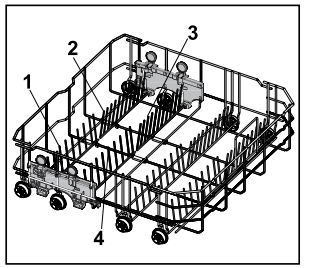

Collapsible lower basket wires (6 pieces) (depends on the model)
The foldable wires (A) located at the lower basket of the machine are designed for an easier placement of large pieces such as pans, bowls, etc. You can create larger spaces by folding each wire individually or all them at once.
To bring the collapsible wires into horizontal position, grab the wire from mid position and push them in the directions of arrows (B) To bring the wires back to vertical position, just lift them up. Collapsible wires will click into the latch again.
NOTE: Bringing the wires to the horizontal position byholding them from the tips may cause them to bend. Therefore, it will be appropriate to bring the wires in the middle to horizontal or vertical position by holding them from their stems and pishing in the direction of arrow.


Collapsible lower basket wires (4 & 8 pieces) (depends on the model)
The foldable wires (A) located at the lower basket of the machine are designed for an easier placement of large pieces such as pans, bowls, etc. You can create larger spaces by folding each wire individually or all them at once.
To bring the collapsible wires into horizontal position, grab the wire from mid position and push them in the directions of arrows (B) To bring the wires back to vertical position, just lift them up. Collapsible wires will click into the latch again (C).
NOTE: Bringing the wires to the horizontal position byholding them from the tips may cause them to bend. Therefore, it will be appropriate to bring the wires in the middle to horizontal or vertical position by holding them from their stems and pishing in the direction of arrow.
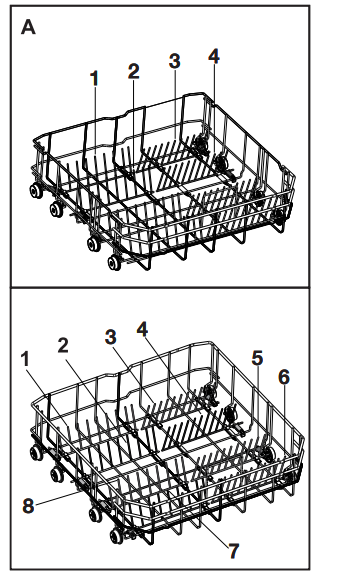
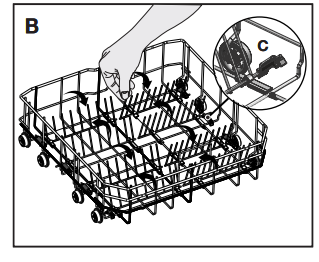
Lower basket multipurpose/ height adjustable service rack (depends on the model)
This accessory located at the lower basket of the machine allows you to easily wash pieces such as extra glasses, long ladles and bread knives.

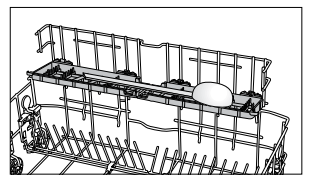

To close the racks:
- Fold the rack (A).
- Slide the rack up (B).
- Put the rack in vertical position (C).
- Slide the rack down and lock it with the tabs (D).
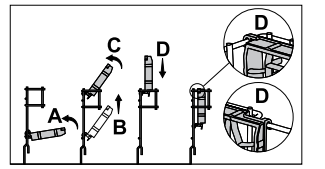
NOTE: Perform the same process in reverse order to open the racks.
To adjust the height of the racks:
- Fold the rack (E).
- Slide the rack up (F).
- Open the rack at the desired level (G).

NOTE: Make sure that the impeller does not touch the dishes you placed on the racks.
Lower Basket Glass Holder (depends on the model)
Lower Basket Glass Holder found in the lower basket of your machine enables a safe washing for your oversized and tall glasses.

SoftTouchAccessory (depends on the model)
The SoftTouch Accessory found in the lower basket of your machine enables a safe washing for your fragile glasses.

Lower basket bottle wire (depends on the model)
The bottle wire is designed for easier washing of long pieces with wide mouths. You may take out the bottle wire from the basket when not in use by pulling it out from both sides (H).

Upper basket height adjustable rack (depends on the model)
Use the lower and upper parts of the height adjustable racks in the upper basket of the machine by sliding them down or up according to the heights of the glasses, cups or etc. (A, B, C).

Upper basket drawer (depends on the model)
You can easily place additional desert spoons, small forks and knives into the basket drawer installed to the upper basket of your machine.

Upper basket glass support piece (depends on the model)
When placing long stemmed glasses or wine glasses, do not lean them against other pieces but to the edge of the basket or to the rack (1). Do not lean long glasses against each other. They can move and get damaged during washing.
If you wish to place large-volume pieces on the upper basket, release the tab of the glass support piece from the upper basket wire it is hooked to. Thus, you can obtain a wider space.


Collapsible upper basket wires (depends on the model)
To bring the collapsable wires on the upper basket of the machine into horizontal position, press on the latch (1). Place your larger dishes into the area created (2). To bring the wires back to vertical position, just lift them up.


Upper basket glass support piece (depends on the model)
When placing long stemmed glasses or wine glasses, do not lean them against other pieces but to the edge of the basket or to the rack (1). Do not lean long glasses against each other. They can move and get damaged during washing.
If you wish to place large-volume pieces on the upper basket, release the tab of the glass support piece from the upper basket wire it is hooked to. Thus, you can obtain a wider space.


Collapsible upper basket wires (depends on the model)
There are collapsible wires on the upper basket of the machine that you can lay down when you need a larger room for big dishes. On your upper basket there are two types of collapsible wires namely, fully laid system (A) and gradually laid system (B). To bring the collapsible wires into horizontal position, push the wires in the direction of the arrow by holding them from the middle. You can place your larger dishes into the area created. To bring the wires back to vertical position, just lift them up. Collapsible wires will click into the latch again.
NOTE: Holding the wires from ends to put them in lying position may cause the wires to bend. For this reason, it will be appropriate to hold the wires in the middle from their bottoms and to push in the direciton of the arrow to lay down or bring them to vertical position.

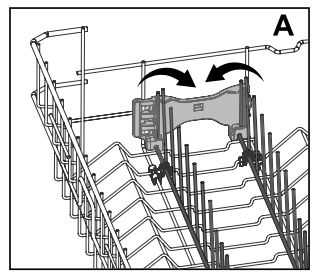

Adjusting the height of loaded upper basket (depends on the model)
Basket adjustment mechanism on the upper basket of the machine is designed to allow you create wider areas in the upper or lover section of the machine based on your requirements by adjusting the height of the loaded basket in up or down directions without removing it from the machine.
To raise the basket:
- Grab one of the upper basket wires (right or left) and lift it up (A).
- Repeat the same process to raise the other side of the basket.
- Make sure that both sides of the basket height adjustment mechanism are at the same level (down or up).

To lower the basket:
- Press the latch on the basket adjustment mechanism (right or left) to lower the basket (B).
- Repeat the same process to lower the other side of the basket.
- Make sure that both sides of the basket height adjustment mechanism are at the same level (down or up).

Adjusting the height of loaded upper basket (depends on the model)
Basket adjustment mechanism on the upper basket of the machine is designed to allow you create wider areas in the upper or lover section of the machine based on your requirements by adjusting the height of the loaded basket in up or down directions without removing it from the machine.
To raise the basket:
- Grab one of the upper basket wires (right or left) and lift it up (A).
- Repeat the same process to raise the other side of the basket.
- Make sure that both sides of the basket height adjustment mechanism are at the same level (down or up).
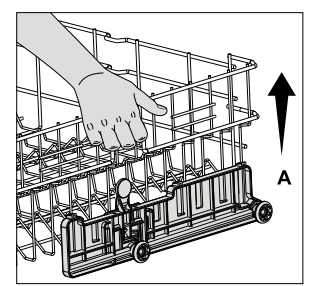
To lower the basket:
- Press the latch on the basket adjustment mechanism (right or left) to lower the basket (B).
- Repeat the same process to lower the other side of the basket.
- Make sure that both sides of the basket height adjustment mechanism are at the same level (down or up).
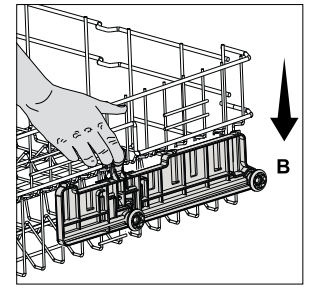
Adjusting the height of empty upper basket (depends on the model)
You can adjust the height of the upper basket according to the size of the dish to be washed. Use basket rollers to change the basket height.
- Turn the stoppers on the ends of the upper basket rails by turning them aside (A).

- Take the basket out (B).
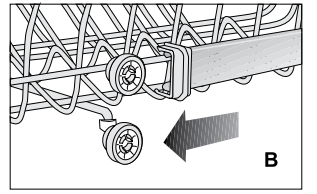
- Change the position of the rollers, place the basket into the rail and close the stoppers (C).

Operating the product


- On/Off key
- Display
- Start/Pause/Cancel key
- Time Delay key
- Function keys
a) Half Load Function
b) Super Rinse Function - Program Selection key
- Programme indicator
- Program Follow-up indicator
- Start (
 )/Pause indicator
)/Pause indicator - Time Delay indicator
- Rinse aid (
 ) indicator
) indicator - Salt (
 ) indicator
) indicator - Tablet Detergent indicator
Keys On/Off key
It is used to turn on or off the machine.
Machine will turn on with economy programme in On mode and the number of the economy programme will appear on the programme indicator. In Of mode, indicators on the display will turn off.
Start/Pause/Cancel key
It is used to startup, pause or cancel the selected program.
Programme Selection key
It is used to select the washing programme you determined from the table of "Programme data and average consumption values".
Delayed Start key
Use to set the time delay duration.
Preparing the machine
- Open the door of the dishwasher.
- Place the dishes in accordance with the instructions in the user manual.
- Make sure that the upper and lower impellers rotate freely.
- Put adequate amount of detergent into the detergent dispenser.
- Check if the Salt and Rinse Aid indicators light and add salt and/or rinse aid if needed.
- Close the door of the dishwasher.
Programme selection
- Press On/Off key to turn on your machine.
- Refer to the table of "Programme data and average consumption values" to determine a washing programme suitable for your dishes.
- Press Programme Selection key until the number of the programme you selected appears on the Programme indicator.
Programme Table

Auxiliary functions
Washing programmes of your dishwasher are designed to obtain the best cleaning effect, considering the type of the soiling, soiling degree and properties of the dishes to be washed.
Auxiliary functions are provided in order to enable you to save time, water and energy and to perform a more comfortable washing with conditions specific to you.
CAUTION: Auxiliary functions may cause changes in the programme duration.
CAUTION: Auxiliary functions are not suitable for all washing programs. Indicator of the auxiliary function that is not compatible with the programme will not be active.
To add auxiliary function to the programme:
- Select the desired washing programme by pressing the programme selection key.
- In the selected washing programme, if auxiliary function is selected, its symbol will be displayed on the screen. If the function key is pressed again the symbol will disappear and selection is cancelled.
Half Load function
It is used to operate the machine without loading it completely. It is used to operate the machine without loading it completely.
- Load your dishes in the machine as you like.
- Turn the machine on with On/Off key
- Select the desired programme and press the Half Load key. The Half Load indicator will light on the display in the Function Selected indicator.
- Start the program by pressing Start / Pause / Cancel key.
NOTE: With the Half Load function you can save both water and power while using the lower and upper baskets of the machine.
Super Rinse Function
Depending on the type of the detergent used, if a detergent dissolving issue is encountered it will remove the resulting stains from the dishes and enables the optimum rinsing performance.
Tablet function
Allows to obtain a better drying performance from the multi-purpose detergents called as all in one detergents such as 2in1, 3in1, 4in1, 5in1 and etc., depending on the hardness level of the tap water. Press and hold the tablet function buttons on the panel to activate the tablet function for appropriate programmes. Selecting the tablet function will light the Tablet Detergent indicator. Salt and Rinse Aid indicators turn off when this function is activated.
NOTE:If you have used the Tablet features during the last washing programme you used, Tablet function will remain active in the next washing programme you will select. If you do not want to use these functions in the new program you have selected, press the Tablet Detergent key until the indicator of the relevant function turns off.
CAUTION: Tablet Detergent function may cause change in the programme duration.
Interior Lighting (Depends on the model)
Some models have interior lighting to illuminate the interior when the door is opened.
Changing the interior lighting setting
- After turning on the machine, press and hold Time Delay and Programme keys simultaneously for 3 seconds.
- Press the programme key until the Rinse Aid icon starts to flash. The applicable options will be displayed on the programme indicator as follows:
Interior lighting ON - [P1]
Interior lighting OFF - [P3] - You can turn ON or OFF the interior lighting with the time delay key.
- Turn off the machine with On/Off key to save the changes.
Floor illumination Warning to show that machine is in washing phase (depends on the model)
Your machine reflects a light to the floor during the washing process. This light turns off after the washing process is complete.
CAUTION: Floor illumination is activated automatically when the washing programme starts and remains lit until the end of the programme.
CAUTION: Floor illumination cannot be cancelled by the user.
Scheduling the washing time
Time Delay
If an economical electricity tariff is applied in your region, you can use the Time Delay function to wash your dishes during appropriate hours. You can delay the start of the selected programme until 3-6-9 hours. Time Delay cannot be set after the programme starts.
- Press the Time Delay function key after selecting the washing programme and other auxiliary functions.
- Time Delay selection mode is activated. 3-hours time delay icon will flash on the display.
- With a second press on the key, 3-hours time delay icon will disappear and 6-hours time delay icon will start to flash. With a third press, 6-hours time delay icon will disappear and 9-hours time delay icon will start to flash.
- Press the Start/Pause key to activate the time delay.
CAUTION: While the Time Delay is active the relevant delay period and start icon will be displayed steadily. For 0-3 hours time delay the 3-hours time delay icon will be displayed, for 3-6 hours time delay the 6-hours time delay icon will be displayed, and for 6-9 hours time delay the 9-hours time delay icon will be displayed.
CAUTION: If the door is opened while the Time Delay is active, the countdown will be paused and start icon will start to flash.
CAUTION: To exit time delay mode without activating the Time Delay, press the time delay key until the 3-6-9 hours duration indicators disappear. Time Delay mode will be cancelled and the programme selection mode will be activated.
Changing the settings while Time Delay function is active
While the Time Delay function is activated, you cannot make changes in the washing programme, auxiliary functions or the duration of delay time.
To cancel the Time Delay function
- Press and hold Start/Pause/ Cancel key for 3 seconds. Time delay period and start/pause icon will start to flash and Time Delay function will be cancelled.
CAUTION: You can select and start a new programme following the cancellation of Time Delay function.
CAUTION: Time Delay function cannot be set after the programme starts.
Starting the programme
To start your machine after selecting the programme and auxiliary functions, press Start/Pause/Cancel key.
CAUTION: Your machine performs water softening depending on the hardness level of the supply water. Due to water softening process the programme duration may change. The programme duration can also change while the programme is running depending on the ambient temperature where your machine is installed, temperature of the supply water and amount of the dishes.
CAUTION: Pay attention not to open the door of the machine when it is running. Stop the machine by pressing Start/Pause/Cancel key if you have to open the door. Then, open the door of the machine. There may be a rush of vapour when you open the door of your machine; be careful. Close the door of your machine and press Start/Pause/ Cancel key again. Programme will resume running.
CAUTION: The machine will remain silent in pause mode for some time in order to remove the water in the machine and on the dishes completely and to have the water softener cleaned, and then it will resume running in drying mode.
Cancelling the programme
- Press Start/Pause/Cancel key for 3 seconds to cancel the programme.
- Release the key when the programme indicator starts flashing. For a couple of minutes the machine will fulfill the necessary operations required to cancel the programme.
CAUTION: There might be residues of detergent or rinse aid in the machine and/or on the pieces being washed depending on the step the programme you have cancelled was in.
Salt indicator ( )
)
Please check the salt indicator on the display to see whether there is adequate amount of softening salt in the dishwasher or not. You need to refill the salt reservoir with salt whenever salt indicator appears on the display of your machine.
CAUTION: Adjusting the water hardness level is explained in Water Softening System section.
Rinse Aid indicator ( )
)
Please check the rinse aid indicator on the display to see whether there is adequate amount of rinse aid in the dishwasher or not. You need to refill the rinse aid reservoir with rinse aid whenever rinse aid indicator appears on the display of your machine.
End of programme
End of Programme indicator will light up once the washing programme is over.
- Press the On/Off key to turn off your machine.
- Close the tap.
- Unplug the machine from the socket.
CAUTION: For energy saving, the machine is automatically turned off following the completion of the programme or if the programme is not started.
CAUTION: Leave your dishes in the machine for about 15 minutes to allow them cool down after they are washed. Your dishes will dry in a shorter time if you leave the door of your machine ajar during this period. This process will increase the drying effectiveness of your machine.
Water cut-off warning
If mains water is cut or water inlet tap is turned off the machine cannot take water in and P2 icon will flash on the programme indicator. As long as the problem continues, washing programme is paused and the water inlet is checked regularly by the machine; when the water is restored P2 icon will disappear after a while and the washing programme resumes.
Overflowing warning
If the machine intakes too much water or there is leakage at any of the components then the machine will detect this and P1 icon will flash on the Programme indicator. As long as the overflowing continues safety algorithm will be active and try to discharge the water. If overflowing stops and safety is assured, P1 icon will disappear. If P1 does not disappear, there is a permanent fault. In this case the authorised service should be contacted.
Maintenance and cleaning
Service life of the product extends and frequently faced problems decrease if it is cleaned at regular intervals.
WARNING: Unplug the product and turn off the tap before attempting any cleaning procedures.
CAUTION: Do not use abrasive substances for cleaning.
CAUTION: Clean the filters and impellers at least once a week.
Cleaning the outer surface of the product
Clean the outer surface and door gaskets of the product gently with a mild cleaning material and damp cloth. Wipe the control panel only with a damp cloth.
Cleaning the interior of the machine
— Clean the interior of the machine and the tank by running a prewash programme without detergent or a long washing programme with detergent based on the degree of soiling.
— If water has remained in the machine, drain the water by performing the procedures under the topic “Canceling a programme”. If the water cannot be discharged, clean any leftover deposits that have piled up in the bottom of the machine, blocking the water path.
Cleaning the filters
Clean the filters at least once a week in order for the machine operates efficiently. Check if food residues are left on the filters. If there are food residues on filters, take them out and clean well under running water.
- Turn the micro filter (1) and coarse filter (2) assembly counter clockwise and pull it out from its seating (A).

- Pull out the metal / plastic filter (3) (B).
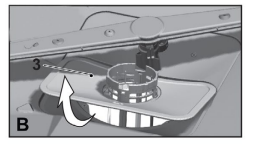
- Press the two pawls on the coarse filter inwards and separate the coarse filter from the assembly (C).

- Clean all three filters under tap water by means of a brush.
- Replace the metal/plastic filter.
- Place the coarse filter into the microfilter. Make sure that it is properly seated. Turn the coarse filter clockwise until a “click” sound is heard.
WARNING: Do not use the dishwasher without filter.
CAUTION: Incorrect placement of the filters will reduce washing efficiency.
Cleaning the hose filter
Damages on the machine that may be caused by impurities coming from the urban supply water or your own water installation (such as sand, dirt, rust, etc.) can be prevented by means of the filter attached to the water inlet hose. Check the filter and the hose regularly and clean them if necessary.
- Turn off the tap and remove the hose.
- After taking out the filter, clean it under running tap water.
- Place the cleaned filter back to its seat in the hose.
- Install the hose to tap. (depends on the model)

Cleaning the impellers
Clean the impellers at least once a week in order for the machine operates efficiently.
Lower impeller
Check if the holes on the lower impeller (1) are clogged. If they are clogged, remove and clean the impeller. Pull the lower impeller up to remove it (A, B).
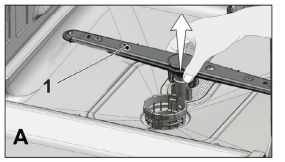


Upper impeller
Check if the holes on the upper impeller (2) are clogged. If they are clogged, remove and clean the impeller. Turn its nut to left to remove the upper impeller (C, D). Make sure that the nut is tightened well when installing the upper impeller.



Troubleshooting
Machine does not start.
- Power cable is unplugged. >>> Check if the power cable is plugged in.
- Fuse is blown. >>> Check the fuses in your house.
- Water is cut. >>> Make sure that the water inlet tap is open.
- Door of the machine is open. >>> Make sure that you have closed the door of the machine.
- On / Off button is not pressed. >>> Make sure that you have turned on the machine by pressing the On / Off button.
Dishes are not washed clean
- Dishes are not placed orderly in the machine. >>> Load the dishes as described in the user manual.
- Selected programme is unsuitable. >>> Select a programme with a higher temperature and cycle time.
- Impellers are stuck. >>> Prior to starting the programme, turn the lower and upper impellers by hand to make sure that they rotate freely.
- Impeller holes are clogged. >>> Lower and upper impeller holes might be clogged with food remnants such as lemon pips. Clean the impellers regularly as illustrated in section “Cleaning and Care”.
- Filters are clogged. >>> Check if the filter system is clean. Clean the filter system regularly as illustrated in section “Cleaning and Care”.
- Filters are installed incorrectly. >>> Check the filter system and make sure that it is installed correctly.
- Baskets are overloaded. >>> Do not overload the baskets in excess of their capacity.
- Detergent is stored under unsuitable conditions. >>> If you are using powder detergent, do not store the detergent package in humid places. Keep it in a closed container if possible. For ease-of-storing, we recommend you to use tablet detergents.
- Detergent is not sufficient. >>> If you are using powder detergent, adjust the amount of detergent according to the soiling degree of your dishes and/or programme definitions. We recommend you to use tablet detergents for optimum results.
- Rinse aid is not sufficient. >>> Check the rinse aid indicator and add rinse aid if necessary. Increase the rinse aid setting if there is enough amount of rinse aid in the machine.
- Detergent dispenser lid is left open. >>> Make sure that the detergent dispenser lid is closed tightly after adding detergent.
Dishes are not dry at the end of cycle
- Dishes are not placed orderly in the machine. >>> Place your dishes in a way that no water will accumulate in them.
- Rinse aid is not sufficient. >>> Check the rinse aid indicator and add rinse aid if necessary. Increase the rinse aid setting if there is enough amount of rinse aid in the machine.
- Machine is unloaded right after the programme is over. >>> Do not unload your machine right after washing process is completed. Slightly open the door and wait for evacuation of the steam inside for a while. Unload the dishes after the pieces cool down to a touchable level. Start unloading process from the lower basket. Thus, dropping of water remained on a piece at upper basket onto the pieces at lower basket is prevented.
- Selected programme is unsuitable. >>> Since rinsing temperature is low at programmes with short duration, drying performance will also be low. Select programmes with longer duration for a higher drying performance.
- Surface quality of the kitchen utensils is deteriorated. >>> Desired washing performance can not be obtained at kitchen utensils with deteriorated surfaces and it is not suitable to use such utensils in terms of hygiene as well. Also, water can not flow easily on deteriorated surfaces. It is not recommended to wash such kitchen utensils in dishwasher.
CAUTION: It is normal that drying complaints can be experienced with Teflon kitchen utensils. It is associated with the structure of Teflon. Since the surface tensions of Teflon and water are different, water droplets will remain as beads on the Teflon surface.
Tea, cafe or lipstick stains remain on dishes.
- Selected programme is unsuitable. >>> Select a programme with a higher temperature and cycle time.
- Surface quality of the kitchen utensils is deteriorated. >>> Tea and cafe stains or other dye spots may not be cleaned in dishwasher when they have penetrated in deteriorated surfaces. Desired washing performance can not be obtained at kitchen utensils with deteriorated surfaces and it is not suitable to use such utensils in terms of hygiene as well. It is not recommended to wash such kitchen utensils in dishwasher.
- Detergent is stored under unsuitable conditions. >>> If you are using powder detergent, do not store the detergent package in humid places. Keep it in a closed container if possible. For ease-of-storing, we recommend you to use tablet detergents.
Lime traces remain on dishes and glassware gains a misty appearance
- Rinse aid is not sufficient. >>> Check the rinse aid indicator and add rinse aid if necessary. Increase the rinse aid setting if there is enough amount of rinse aid in the machine.
- Water hardness setting is low or salt level is insufficient >>> Measure the hardness of the supply water appropriately and check the water hardness setting.
- Salt leakage exists. >>> Pay attention not to spill salt around the salt filling hole while adding salt. Make sure that the salt reservoir lid is tightly closed after finishing the filling process. Run the prewash programme to remove the salt that spilled inside the machine. Since the salt granules that will remain under the lid will dissolve during prewash, causing the lid loosen, check the lid once again at the end of the programme.
There is a different odour in the machine
CAUTION: A new machine has a peculiar odour. It will fade out after a couple of washing.
- Filters are clogged. >>> Check if the filter system is clean. Clean the filter system regularly as illustrated in section "Cleaning and Care".
- Dirty dishes are kept in dishwasher for 2-3 days. >>> If you are not going to start the machine right after you have put the dishes into it, remove the remnants on the dishes and run the Prewash programme without detergent every 2 days. In such cases, do not close the door of the machine completely in order to avoid odour build up in machine. You can also use commercially available odour removers or machine cleaners.
Rust, discoloration or surface deterioration occurs on dishes
- Salt leakage exists. >>> Salt may cause deterioration and oxidation on metal surfaces. Pay attention not to spill salt around the salt filling hole while adding salt. Make sure that the salt reservoir lid is tightly closed after finishing the filling process. Run the prewash programme to remove the salt that spilled inside the machine. Since the salt granules that will remain under the lid will dissolve during prewash, causing the lid loosen, check the lid once again at the end of the programme.
- Salty food remnants have remained on dishes for a long time. >>> If silverware soiled with such foods will be kept waiting in machine, dirt must be removed by prewash or dishes must be washed without being kept waiting.
- Electric installation is not grounded. >>>Check if your machine is connected to the actual grounding line. Otherwise, the static electric created in the product causes arcs on the surfaces of metal items creating pores, removing the protective cover on the surface and causing discoloration.
- Intensive cleansers such as bleaches are used. >>> Protective cover on metal surfaces gets damaged and looses its efficiency in time when it gets in contact with cleansers such as bleach. Do not wash your dishes with bleach.
- Metal items particularly such as knives are used for purposes other then their intended uses. >>> Protective cover on the edges of knives may get damaged when they are used for purposes such as opening cans. Do not use metal kitchen utensils out of their intended uses.
- Silverware are made of low quality stainless steel. >>> Corrosion on such items is inevitable; they should not be washed in dishwashers.
- Kitchen utensils that are already corroded are washed in dishwasher. >>> Rust on a corroded item can migrate to other stainless steel surfaces and cause corrosion on those surfaces as well. Such items should not be washed in dishwashers.
Detergent remains in detergent dispenser.
- Detergent dispenser was damp when adding detergent. >>> Make sure that the detergent dispenser is dried well prior to filling it with detergent.
- Detergent is added long before the washing process. >>> Pay attention to add detergent shortly before start-up of the washing.
- Opening of the detergent dispenser lid is prevented during washing. >>> Place the dishes in a way that will not prevent the detergent dispenser lid from opening and the water going into the machine from impellers.
- Detergent is stored under unsuitable conditions. >>> If you are using powder detergent, do not store the detergent package in humid places. Keep it in a closed container if possible. For ease-of-storing, we recommend you to use tablet detergents.
- Impeller holes are clogged. >>> Lower and upper impeller holes might be clogged with food remnants such as lemon pips. Clean the impellers regularly as illustrated in section "Cleaning and Care".
Decorations and ornaments on kitchen utensils are being erased.
CAUTION: Decorated glasses and decorated luster porcelains are not suitable for washing in the dishwasher. Manufacturers of glassware and porcelain tableware items do not recommend washing such kitchen utensils in the dishwashers either.
Dishes are scratched.
CAUTION: Kitchen utensils that contains or are made of aluminum should not be washed in dishwasher.
- Salt leakage exists. >>> Pay attention not to spill salt around the salt filling hole while adding salt. Spilled salt can cause scratches. Make sure that the salt reservoir lid is tightly closed after finishing the filling process. Run the prewash programme to remove the salt that spilled inside the machine. Since the salt granules that will remain under the lid will dissolve during prewash, causing the lid loosen, check the lid once again at the end of the programme.
- Water hardness setting is low or salt level is insufficient >>> Measure the hardness of the supply water appropriately and check the water hardness setting.
- Dishes are not placed orderly in the machine. >>> When placing the glasses and other glassware into the basket lean them not against other dishes but the edges or racks of the basket or the glass support wire. Striking of the glasses to each other or to other dishes due to the impact of water during washing can cause breaks, or scratches on their surfaces.
A smear remains on glasses that resembles milk stain which can not be removed when wiped by hand. A bluish / rainbow appearance occurs when the glass is pointed to light.
- Excessive rinse aid is used. >>>Lower rinse aid setting. Clean the spilled rinse aid when adding rinse aid.
- Corrosion has occurred on glass due to soft water. >>> Measure the hardness of the supply water appropriately and check the water hardness setting. If your supply water is soft (<5 dH), do not use salt. Choose programmes that wash in higher temperatures (e.g. 60-65°C). You can also use glass protective detergents that are commercially available.
Foam forms in the machine.
- Dishes are washed with hand-wash detergent by hand but not rinsed before placing them into the machine. >>> Hand-wash detergents do not contain antifoam. There is no need to hand-wash the dishes before placing them into the machine. Removing the coarse soil on the dishes under tap water, with a tissue paper or fork will be sufficient.
- Rinse aid has spilled into the machine when adding rinse aid. >>> Take care that rinse aid is not spilled in the machine when you are filling it. Clean any spilled rinse ait with the help of a tissue paper/towel.
- Lid of the rinse aid reservoir is left open. >>> Make sure that the lid of the rinse aid reservoir is closed after adding rinse aid.
Kitchen utensils are broken.
- Dishes are not placed orderly in the machine. >>> Load the dishes as described in the user manual.
- Baskets are overloaded. >>> Do not overload the baskets in excess of their capacity.
Water remains in the dishwasher at the end of the programme.
- Filters are clogged. >>> Check if the filter system is clean. Clean the filter system regularly as illustrated in section “Cleaning and Care”.
- Discharge hose is clogged/blocked. >>> Check the discharge hose. If necessary, remove the discharge hose, clear the blockage and insert is as illustrated in the user manual.
CAUTIION: If you cannot eliminate the problem although you follow the instructions in this section, consult your dealer or the Authorised Service Agent. Never try to repair a nonfunctional product yourself.

